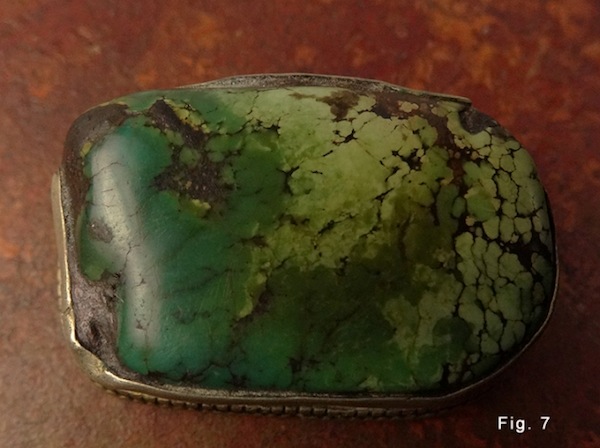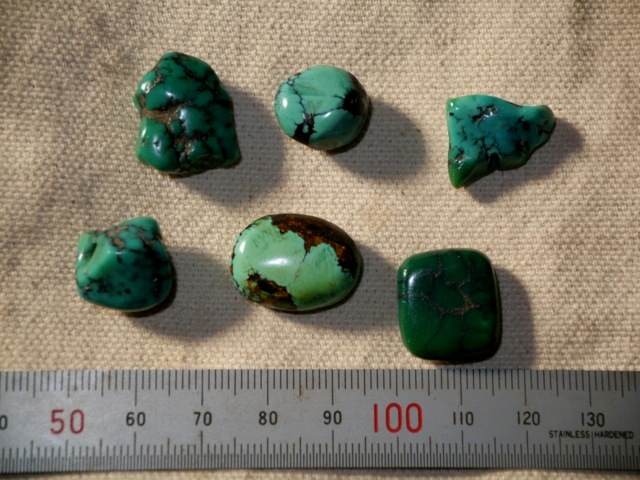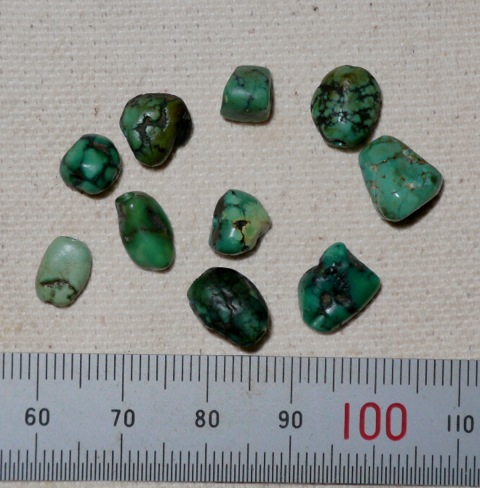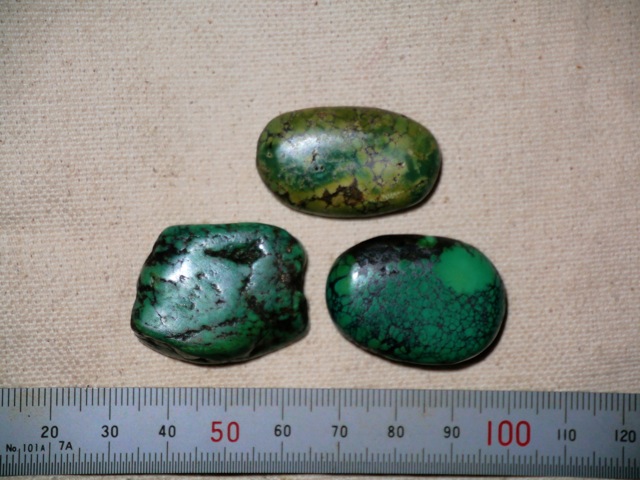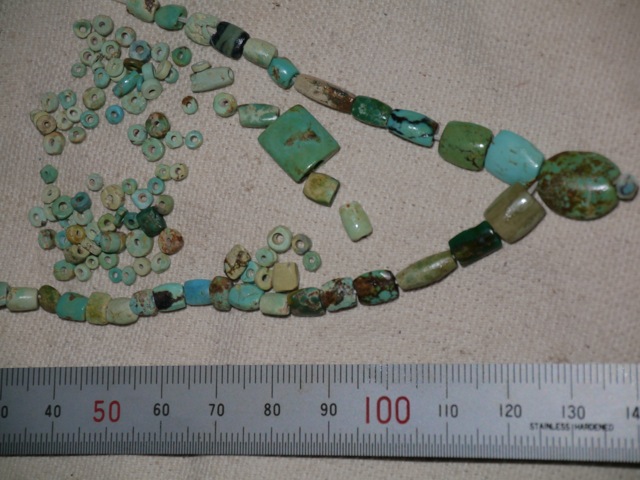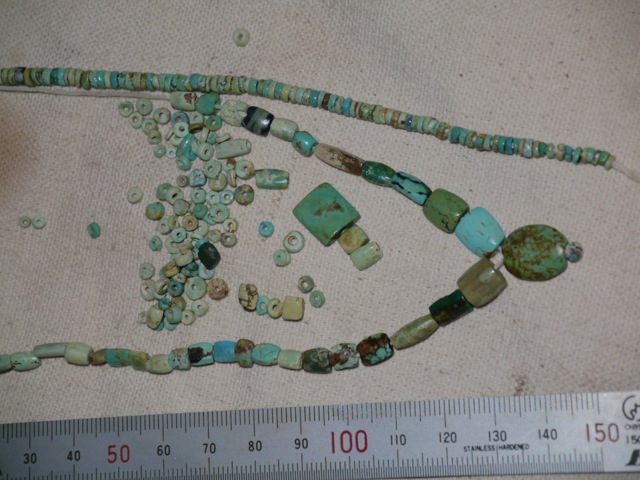
August 2013
John Vincent Bellezza
Welcome to the Seventh Anniversary issue of Flight of the Khyung! Given this auspicious occasion, I would like to heartily thank regular readers, some of whom have been following this newsletter since its inception. Let me also take this occasion to greet those who might be new to this online publication. May you find something of interest among its pages. This month we will once more touch the very heights of ancient civilization in Tibet. We shall begin our flight by examining a curious assortment of ancient shrines carved and painted in Upper Tibet. This is followed by a primer on the antique turquoise of the Tibetan world, revealing a surprising variety of beautiful, semi-precious stones.
A unique collection of ancient ceremonial monuments, both drawn and carved
In Upper Tibet, many likenesses of shrines and tabernacles are found among its rock art. Those who regularly read this newsletter and my print publications will already be familiar with them. Beginning sometime in the protohistoric period (100 BCE to 650 CE), shrines consisting of three to seven graduated tiers upon which a small spherical body sometimes rests appeared on cliffs and boulders in many places of Upper Tibet.
The remains of actual stone and mortar shrines were discovered at a few ruined castles and temples of the region (for more information, see Zhang Zhung and Antiquities of Zhang Zhung; for bibliographic information click on http://www.tibetarchaeology.com/books/). These masonry structures appear to have been used to enshrine and propitiate deities, a custom that has continued in Tibet to the present day. While tiered shrines of the ancient design are uncommon in contemporary Tibet, the wild herbivore horns, sacred stones, and juniper embellishing modern shrines are of archaic cultural origins, as noted in Tibetan texts.
Starting in the early historic period (650–1000 CE), multi-tiered shrines known as chortens (mchod-rten) appeared throughout Tibet. The religious inspiration for these monuments came from India and the Buddhist stupa, while architectural inspiration in part was derived from the indigenous tradition of shrine building in Tibet. Chortens were also commonly engraved and painted on stone surfaces in Upper Tibet. A variety of popular forms are represented in this rock art. Some have the ‘horns of the bird, sword of the bird’ (bya-ru bya-gri) finial of Bon, some the sun and moon (nyi-zla) finial of Buddhism, while still others have neither, or are topped with something in between the standard Bon and Buddhist crowns. This variety in finials (tog) suggests that sectarian differences in architecture had not yet fully crystallized in the early historic period.
The painting and carving of chortens was carried out as a devotional act, as demonstrated occasionally by an accompanying inscription complete with the proper name of an individual. This art was generally made to acquire religious merit. Although the religious environment was very different, a similar motivation may have also prevailed in the protohistoric period, with creators of rock art chortens seeking the favor of the deities. These facsimiles of shrines may also have been made as charms and for cleansing defilements caused by transgressing the gods.
In addition to more popular types of protohistoric and early historic rock art shrines, there are one-of-a-kind versions. The strange in archaeology and science has a special allure, so let us have a peek at the idiosyncratic.
Please note: All dates given below are estimates based on stylistic analysis, examination of the physical qualities of carvings and paintings, the nature of rock art in general at each site, and cross-cultural comparisons. These dates should be viewed as suggestive.

Fig. 1. This sinuous form would hardly be recognizable as the likeness of a shrine if it was not for the three-pointed finial. This trident-like motif crowns many early ceremonial monuments in rock art. Protohistoric period. Note the animal carvings (finished and unfinished) to the right of the shrine. By virtue of their more heavy re-patination, these figures appear to be older than the shrine.

Fig. 2. This red ochre specimen has a pyramidal base divided into six sections. At the peak of this pyramid is a wide flange and above that a smaller triangle. A circle was added to the highest point of this tricorn finial. Two sets of long banners extend from the sides of the shrine. Protohistoric period or early historic period.

Fig. 3. A red ochre shrine comprised of a base in four levels, a short, thin spire (’khor-lo), and a crescentic finial. Protohistoric period.

Fig. 4. A simply engraved shrine consisting of a two-tiered blocky base and a triangular top. Protohistoric period or early historic period.

Fig. 5. A shrine of graduated tiers, three or four of which are ornamented with a circle in the center. Protohistoric period or early historic period. A simple spire rises above the rounded upper layers of the shrine. Protohistoric period.

Fig. 6. A relatively complex shrine with a base of four steps, the lowermost of which is divided into four sections. Dots are found in two or three tiers; these may represent niches or openings in the structure. Above the base is a rounded body (bum-pa) and above that a flange (harmika) upon which rests a pyramidal spire. The spire is surmounted by a trilobate finial. This specimen has many morphological features in common with the chorten, and probably dates to the early historic period. However, it is possible that Tibetans in the west were first inspired by the stupa architecture of northern India at a somewhat earlier date, harnessing it to produce shrines of non-Buddhist persuasion. Note the Tibetan syllable Om in the upper right hand corner of the photograph, a portion which was carved over the shrine.

Fig. 7. A red ochre shrine with a five tiered base. The lowest tier is T-shaped. Above the highest step is the small round body or bumpa of the structure. The finial somewhat resembles the ‘bird horns’ of the Bonpo. Protohistoric or early historic period.

Fig. 8. A multi-tiered shrine with a finial not unlike the one in fig. 3. Much of this shrine has been obscured by subsequent pounding of the rock face with a hard object. Protohistoric or early historic period.

Fig. 9. A multi-tiered shrine resembling a chorten, each step of which is segmented. There is no finial visible above the segmented spire. Probably early historic period.
Tibetan turquoise: Beaming stone of life
General introduction
Of all the stones on Earth none is more sacred and important to Tibetans than turquoise. Turquoise is the nation’s most precious signifier of personal happiness, social affiliation, and the divine presence. Thus for Tibetans, turquoise is synonymous with fertility, prosperity, and well being. It is their seminal symbol of love and life itself.
Often classed as a feminine substance, turquoise is considered the counterpart of gold, the male material par excellence (on gold, see April 2011 Flight of the Khyung). Yet, given its universal cultural connotations in Tibet, turquoise has been worn, enshrined, and used as a decorative agent by both sexes and all walks of life since time immemorial.
Indeed, turquoise is one of the oldest gemstones known to humanity. The ancient Persians, Egyptians, Chinese, and native peoples of the Americas, as well as the Tibetans, were no strangers to its formidable attractions. The great antiquity and nativeness of turquoise in Tibet is suggested by the manner in which it is so deeply ingrained in the origins myths, pre-Buddhist customs, and archaic religious traditions of Tibet. No other substance is as prominent in Tibetan literature as turquoise.
According to the online article Introduction to the Meaning and Uses of Turquoise, “Turquoise beads dating back to 5000 B.C. have been found in Iraq, and the Egyptians were mining the stones in the Sinai in 3200 B.C. The death mask of Tutankhamun was studded with Turquoise, as were the mosaic masks dedicated to the gods, the fabulous inlaid skulls, shields and power statues of Moctezuma, the last ruler of the Aztecs.” See http://www.crystalvaults.com/crystal-encyclopedia/turquoise
According to Wikipedia, “The substance has been known by many names, but the word turquoise, which dates to the 16th century, is derived from an Old French word for ‘Turkish’, because the mineral was first brought to Europe from Turkey, from the mines in historical Khorasan province of Iran. Pliny the Elder referred to the mineral as callais, the Iranians named it ‘phirouzeh’ and the Aztecs knew it as Teoxihuitl.” See http://en.wikipedia.org/wiki/Turquoise
According to mindat.org, the chemical formula of turquoise is CuAl6(PO4)4(OH)8•4H2O; it has a hardness (Mohs) of 5 to 6, its crystal system is triclinic-pinacoidal, it has a conchoidal fracture, a pale greenish blue to white streak, and is bright blue, sky-blue, pale green, blue-green, turquoise-blue, apple-green, or green-gray in color. Mindat.org states that turquoise is: “A secondary mineral occurring in the potassic alteration zone of hydrothermal porphyry copper deposits. Also formed by the action of meteoric waters, usually in arid regions, on aluminous igneous or sedimentary rocks (as vein filling in volcanic rocks and phosphatic sediments.” See http://www.mindat.org/min-4060.html).
According to Wikipedia: “Climate factors appear to play an important role as turquoise is typically found in arid regions, filling or encrusting cavities and fractures in typically highly altered volcanic rocks, often with associated limonite and other iron oxides. Typically turquoise mineralization is restricted to a relatively shallow depth of less than 20 m, although it does occur along deeper fracture zones where secondary solutions have greater penetration or the depth to the water table is greater.” See http://en.wikipedia.org/wiki/Turquoise
An introduction to turquoise in Tibetan culture and history
Unless otherwise referenced, this introduction to Tibetan turquoise is derived from my print publications with the addition of some new insights. Here I will only touch upon a few cultural and historical highlights. To really do the subject of Tibetan turquoise justice would require a book-length project.
The common name for turquoise in Tibetan is yu (g.yu). According to the “Zhangzhung Dictionary” of Dan Martin, the Zhang Zhung word for turquoise was ting or ting-zhi, words that also denote water or qualities of water.* Turquoise is also called tshoro (mtsho-ro), a Tibetan word that means ‘essence/residue of the lake’. This word is supposedly of Zhang Zhung origins, but while its signification may have been inspired by Zhang Zhung tradition, the word itself is Tibetan. The equivalent term in the Zhang Zhung language does not appear to have survived (unless it is ting-ne?). According to another source used in Martin’s “Zhangzhung Dictionary”, yule (g.yu-le) is also a Zhang Zhung word for turquoise (p. 58), but this term is actually from the Old Tibetan language.
* See Martin, D. 2010. “Zhangzhung Dictionary” in Revue d’Etudes Tibétaines, pp. 94, 95, 97, no. 18, April, 2010, pp. 33–253. Paris: CNRS. http://himalaya/socanth.cam.ac.uk/collections/journals/ret/pdf/ret_18_02.pdf
Turquoise is thoroughly embedded in Tibetan culture in a myriad of ways. The word appears as part of the appellations of various ancient gods and goddess. It is also an attribute of many deities encompassing the color of their bodies, clothes, and implements. Chu-lcam rgyal-mo, the Bon queen of existence, is described as turquoise blue in color, as is Kuchi Mangke (Ku-byi mang-ske), a chief god of Zhang Zhung. The cosmogonic grandmother Namchi Gunggyal (Gnam-phyi gung-rgyal) and the famous mountain god Nyenchen Thanglha (Gnyan-chen thang-lha), among other great spirits, are said to have turquoise eyebrows. Deities and primal heroes such as Sripa Sangpo Bumtri (Srid-pa sangs-po ’bum-khri, the father of the gods) and Yangel (Ya-ngal, the priest of the first Tibetan king) have turquoise braids or locks.
According to Tibetan ritual literature, the castles (or various parts of them) and tents of deities are also made of turquoise, and the wealth held in store is often turquoise (and gold). Sacred animals in the entourages of divinities, as manifestations of divine forms in in their own right, and as clan totems are also closely associated with turquoise. Thus we find turquoise dragons, turquoise fish, turquoise serpents, turquoise doe, turquoise birds, and turquoise bird eggs, as well as horses and lions with manes of turquoise. There are also turquoise female yaks, the mounts of chthonic goddesses. Some ancient goddesses are said to have appeared from turquoise eggs; e.g., the goddess of female yaks, Drilam Shampo (’Bri-lha sham-po), and the celebrated lake goddess of Mapang Yumstho (Ma-pang g.yu-mtsho).
In both the religious and secular prosody of Tibet, turquoise is used as a metaphor for the verdancy of topographic features. Here we find the turquoise mountain, the turquoise valley and the turquoise mist. However, the most popular form is the turquoise lake (yumtsho, g.yu-mtsho), a definite reference to the bright color and clarity of many large bodies of water in Tibet. So common is this usage that it has come to mean lake itself. Many lakes in Upper Tibet carry yumtsho as an integral part of their names. Likewise, the blue color, resplendence, and limpidity of the sky is portrayed by the word turquoise. The adjective turquoise is also regularly used in conjunction with flowers and the foliage of juniper trees.
A major divine symbol of womanhood in ancient Tibet was the turquoise spindle, ceremonially bestowed at birth and carefully guarded throughout a lifetime (the male counterpart is the golden arrow). Turquoise in this context does not necessarily mean that the spindle was made of this material, but rather denotes its color as emblematic of the female gender. At death the spindle was used as a key funerary ritual implement in assisting women to attain the ancestral paradise.
In Tibetan culture, there are many external receptacles for the soul, which help support the life of human beings. The higher the social status of the individual, the grander the objects. Those of much power and prestige may have had an entire lake or mountain as the seat of their soul (lanay, bla-gnas). It was often the case that there was more than one external site for an individual soul. The most widespread portable lanay was a fine piece of turquoise called layu (bla-g.yu). These were worn around the neck or secured on the household altar. Some old layu have small silver or gold pins drilled in them. The function of this modification to highly cherished turquoises is uncertain. A lado turquoise that assumed an unsightly pale or dark was perceived as a sign of illness besetting its owner. In the archaic funerary ritual texts of Dunhuang, a chipped or cracked turquoise is used as a metaphor for death.
Therefore, Tibetans always handle turquoise with respect. As Martin Walker-Watson writes, “Traditional lore avers that as turquoise is susceptible to the personality of the wearer, a gem must be treated with affection and regarded as a sentient being if its colour and lustre are to be maintained and improved.”*
* See Walker-Watson, M. 1983. “Turquoise: The Gemstone of Tibet” in The Tibetan Review, June 1983. http://www.gildedbuddha.com/articles.htm
In the Tibetan ritual tradition of the last millennium, turquoise is classed among the five precious substances (rin-chen sna-lnga), which also includes silver, gold, coral, and pearl. Turquoise is one of the most ubiquitous objects of offering in rituals. The list of these rituals is long but includes the propitiation of the deities (gsol-kha), good fortune summoning (g.yang-’gugs), long-life summoning (tshe-’gugs), rescue of the soul (bla-bslu), and calling down the gods in trance (lha-bzhugs). It is written that in early times turban-clad gshen priests placed gold and turquoise on either side of their mouth to demonstrate the power and worth of their words. Appropriately, these objects were called ‘mouth gold’ (kha-gser) and ‘mouth turquoise’ (kha-g.yu).
As in life, turquoise was an aid in death. In Tibetan archaic funerary rites, turquoise bird horns were placed on the psychopomp horse, a sign of this animal having the capability to fly in space, and which acted as a lamp to illuminate the way through the murky postmortem hell (gshin-yul mun-pa). The sacrificial sheep of pre-Buddhist death rites was imagined as transformed into precious materials, its eyes simulating turquoise. In an origins myth found in the Dunhuang text PT 1134, one of the topographic signposts on the way to the celestial heaven is a boulder of turquoise as large as a yak from which a spring issues. It is reported that turquoise has been discovered in ancient tombs in Upper Tibet. Unfortunately, these finds have not been studied properly by archaeologists.
It is written that, as a sacred material, turquoise was used to produce the armor, helmets, and weapons of various deities and epic heroes. An insignia (yig-tshang) of turquoise was conferred by Tibetan kings on those of the high political ranking such as ministers. A Bon historical text relates that a protohistoric Tibetan king awarded a priest of Zhang Zhung, Gyerchen Tsophen (Gyer-chen btso-’phen), turquoise as an award for helping defeat the Chinese kingdom. The text states that from that time, the Bonpo have worn turquoise around their necks. Although this story is apocryphal, it does demonstrate the great value placed upon turquoise in Tibetan culture.
Some deities are envisioned wearing a turquoise head ornament (g.yu yi zur-phud), which was also used by one of the eight core commanders of imperial Tibet, Khyungpo Mepo (Khyung-po mes-po). Another type of highly prestigious turquoise head ornament was called yuyi thorchok (g.yu yi thor-cog). Also in ancient times, regal headgear with turquoise for males called trapue (pra-phud) and trokshu (prog-zhu) were known. The counterpart for females was the zeprok (ze-prog) coronet. According to Bon literature, great priests and potentates of ancient times also erected horns of turquoise on their heads as a kind of crown.
In a more humble form, the pastoralists and farmers of Tibet have for centuries worn headdresses studded with turquoise. In Purang, this horn-like headdress is called genchung (rgan-chung; the collar ornamented with coral that is tied around the neck is called ske-sbug, and the gem-studded flap hung over the back is the rgan-leb). In the drokpa region of Shungpa, the part of the headdress on top of the head is called pechung (pe-chung/be-chung), while the long tail studded with turquoise, coral, and other ornaments that hangs over the back is the lenjuk (lan-mjug). The pechung and lanjuk are also known among the Apa Hor tribes of the eastern Changthang, but styles vary from region to region. In Ladakh, Ruthok and Guge, the headdress is called perak (pe-rag/be-rag). Of all of these head coverings, the Ladakhi version sports the largest number of turquoises. In regions of Guge, Gar, and Gegye, the headdress adorned with turquoise, coral, and other precious objects is called pathruk (spa-phrug). This is also the name of the pronged tiara donned by women of higher social status in Lhasa. Its counterpart in Shigtase is the pagor (spa-sgor) chaplet. Some women of Kham, in eastern Tibet, wear a big piece of turquoise just above the forehead, which is referred to as the ‘flower’ (me-tog). Turquoise is also customarily exploited to ornament a wide range of jewelry from rings to charm boxes and earrings to silver belts. The sheathes of knives and swords, flint pouches, sewing needle holders, cases for religious implements, and other objects are also encrusted with turquoise.
In Tibetan medicine, specially processed turquoise is used to treat poisoning, purify the blood, and cure fevers, eye diseases, and disorders of the liver. Traditionally, to guard against poisoning, the drinking cups of the nobility had a turquoise set with gold mounted inside.
Gemological qualities of turquoise in Tibet
Special types of Tibetan turquoise (g.yu) include gajang (ga-ljang, green in color), drukar (drug-dkar, blue with a whitish cast), yumar (g.yu-dmar, drug-dmar, reddish in color), and matang yu (ma-tang g.yu, of a very fine quality). An especially resplendent turquoise is poetically referred to as ‘turquoise lamp’ (g.yu-sgron), or simply as ‘lamp’ (sgron-ma).
According to Walker-Watson (see reference above), there are four major sources of turquoise in Tibet: one is the Gangkar (Gangs-dkar) range in western Tibet, another is near Chamdo (Chab-mdo), and two more lie in the vicinity Bathang and Derge (Sde-dge), in eastern Tibet. However, I have be unable to confirm if any of these mining regions are still producing turquoise today. As is well known, Tibetans nowadays most highly value the so-called robin’s egg blue turquoise without flaws or visible matrix above all other kinds. Generally speaking, the greener the turquoise and the more intrusive the matrix, the lower the value of the stone (cf. Walker-Watson, reference as above).
It is widely known that if much heat is applied to turquoise it can change color, going from blue to green. Tibetans say that turquoise will also change color according to the health and state of mind of its wearer. Over generations of use, turquoise is susceptible to darkening or yellowing. A negative change in color can also be caused by loss of the stone’s natural water content (Walker-Watson, reference as above).
These days much of the turquoise traded is artificially colored, heat treated, and chemical stabilized, if it is even real at all. There is also plenty of reconstituted and synthetic turquoise on the market and other stones that are passed off as turquoise. One must have a good deal of experience to discern the real item from degraded and counterfeit varieties. For a discussion on the properties of fake turquoise, see Walker-Watson (reference as above).
Thus, to really appreciate authentic Tibetan turquoise, it is best to turn to older examples of the gemstone. As turquoise was used almost universally in Tibet, a great supply was either obtained domestically or imported from other countries such as Iran and China. As a first step in attempting to differentiate indigenous Tibetan turquoise from foreign variants, all types of antique turquoise found in Tibet should be classified. While I am not qualified to do this specialized work, I shall furnish a pictorial inventory of different kinds of old turquoise sourced on the Tibetan plateau. I distinguish these stones solely on the basis of appearance, not through the more technical means employed by gemologists.
My aim is to share with readers the remarkable variety of antique turquoises that have appeared in Tibet. Clearly, this spectrum of stones originated from many sources and over a long period of time. I would think that no fewer than 15 different mines are represented in the photographs below. As much of the turquoise of Tibet has been sold off in the last three decades, this documentation takes on added significance.
The turquoises photographed are from various dealers and collectors in Tibet, Ladakh, and Nepal. They are all beads, meaning that they have a hole running through them that can be used to pass a string through or to attach metal clips for affixing to a headdress. Finally, it must be stated that this is by no means a complete cross-section of turquoises associated with the Tibetan cultural realm. There are surely other types that have been overlooked.
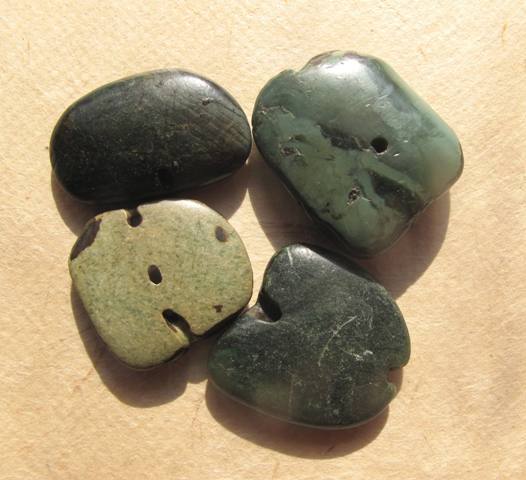
Fig. 10. A very unusual and ancient turquoise. It is blackish or grayish green in hue, but perhaps its color has altered over the centuries. Pieces of this type of turquoise are very thin and some are slightly mottled. These stones exhibit a deep but dull sheen and are always very highly worn and patinated. Due to the physical signs of wear and rarity, I suppose that this species of turquoise is many centuries old. I would also conjecture that given its very distinctive characteristics, the mine(s) from which it came has been long depleted.

Fig. 11. This teal-green to lime-green colored turquoise is also found with many signs of heavy wear but not to the extreme degree like the turquoises in fig. 10. It typically has a subdued patina and comes in rather thick pieces. Its matrix appears in small patches. I would venture to guess that this uncommon type of turquoise may be as much as 500 years old and from a mine no longer in production.
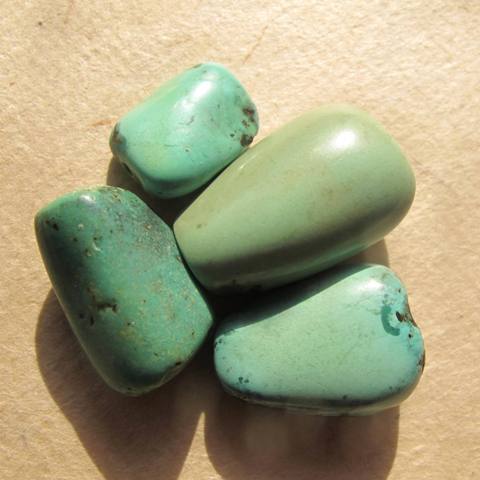
Fig. 12. These pale blue-green, uniformly colored turquoises have a deep patina and a very smooth texture. Flecks or tiny streaks of the dark matrix appear on some beads. This type of turquoise is still sought after by Tibetans. It was used to ornament statues and reliquary chortens in Tibet for centuries, helping to explain its cultural value. Turquoises of this kind exhibit evidence associated with much use. I would not be surprised if some of the beads shown in the photograph are more than 300 years old. Perhaps this is the kind of turquoise that was originally called drukar.
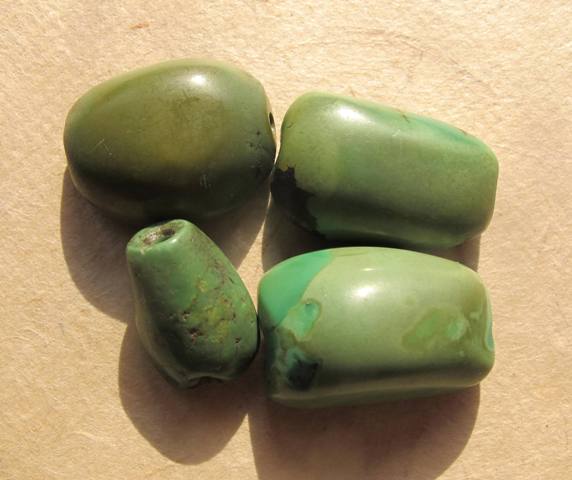
Fig. 13. Pale jade green colored turquoises sharing the same set of visible physical traits as those in Fig. 12. The stones also display comparable heavy wear around the holes and in other locations, and the same well developed patina. Perhaps these two sets of turquoises came from the same mine or groups of mines.
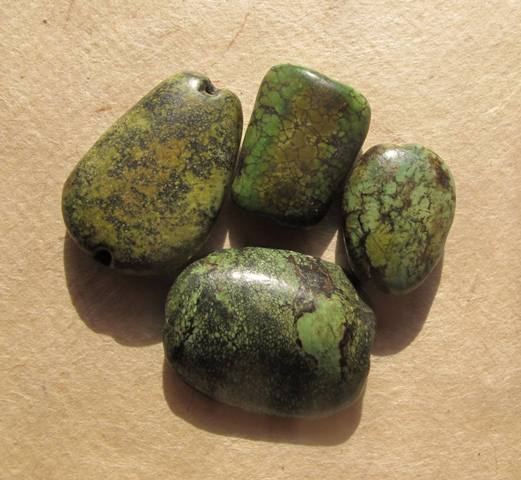
Fig. 14. Forest-green to olive-green colored turquoises with a speckled or stippled matrix. The physical wear characteristics of these richly patinated turquoises are also indicative of significant age. I have seen this kind of turquoise primarily in Ladakh and western Tibet. This may suggest that it is native to these regions.
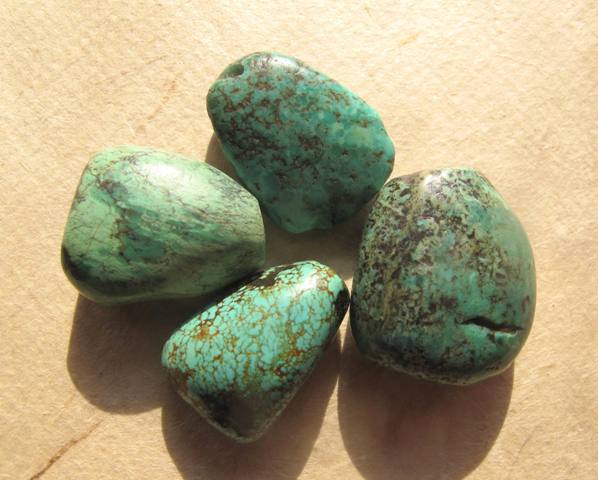
Fig. 15. Turquoises in a true ‘turquoise’ color with a delicately striated or irregular matrix. This type of turquoise has a warm patina and exhibits signs of heavy wear and long usage. Through age, reddish depositions have formed on the beads.
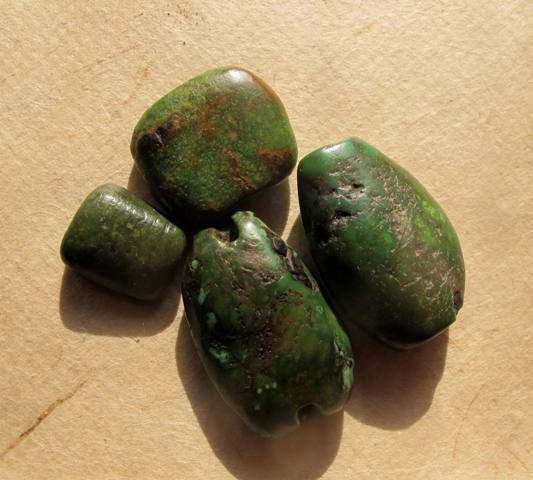
Fig. 16. An olive-green colored turquoise with tiny yellow-green points and a matrix that can form small protuberances on the bead. Like the other turquoises shown so far, this type has all the physical indications of being of considerable age.
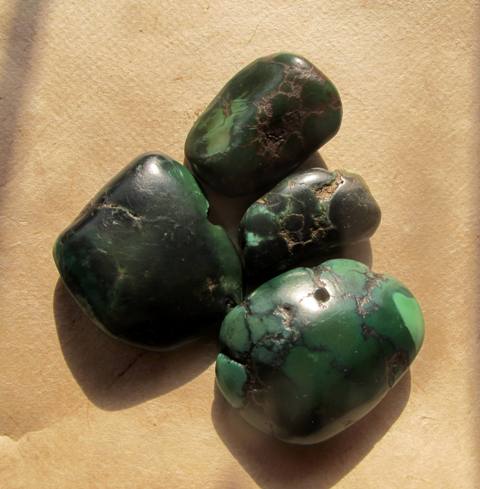
Fig. 17. Turquoises varying in color from very dark-green to a pastel-green, with a matrix that creates fissures on the surface of the bead. These stones because of their weight and glassy surface gives the impression of being a particularly hard variety. The substantial wear of the beads reveals that this is also a stone of significant age.
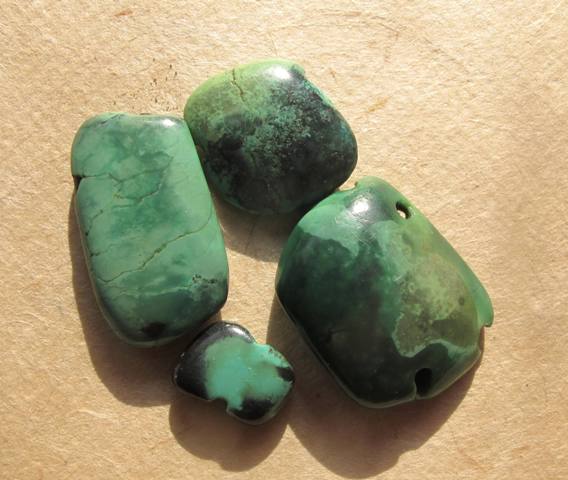
Fig. 18. These turquoises are very similar to that in fig. 17. Perhaps they came from the same mine or groups of mines. The smoothness, advanced patina, and surface color of different hues make these very desirable stones aesthetically speaking.
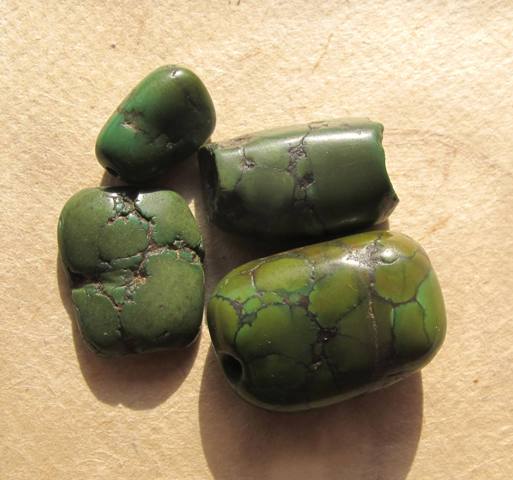
Fig. 19. On close inspection at least two types of green turquoise can be seen in this photograph. The three emerald-green beads with a furrowed surface are of one kind, and the lighter green bead with the jigsaw matrix is another kind (bottom right of image). These specimens are also antique variants.
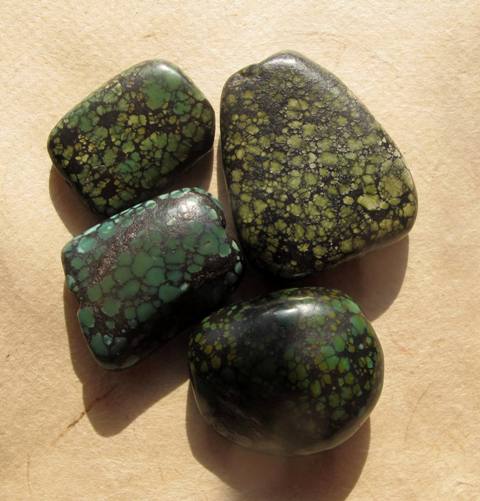
Fig. 20. Teal-green and forest-green turquoises with a spider-web matrix. There are also turquoises with the same matrix pattern in a very pale blue or green color. This species of turquoise is most commonly encountered in Ladakh, raising the question as to whether it was mined there. Nevertheless, to my knowledge there are no active turquoise mines in Ladakh.
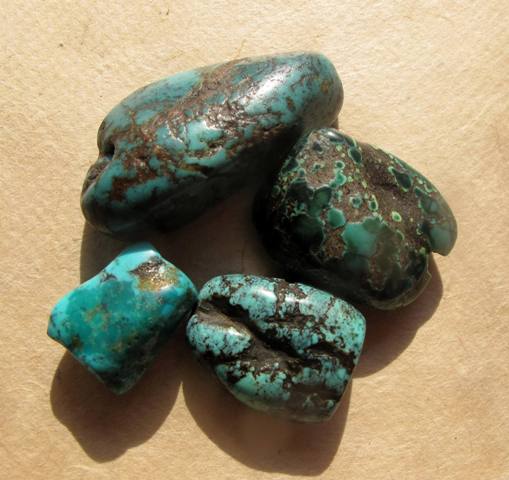
Fig. 21. A selection of old blue turquoises of two or more types. The three larger stones have a fissured matrix. The smallest bead has small areas of a light colored matrix and is of a type of turquoise highly coveted by Tibetans. This species of turquoise is probably of Persian or Afghan origins. The highest quality turquoises have an even richer blue color, are more lustrous, and have no exposed matrix. I wonder if Tibet ever had mines bearing bright blue turquoise?
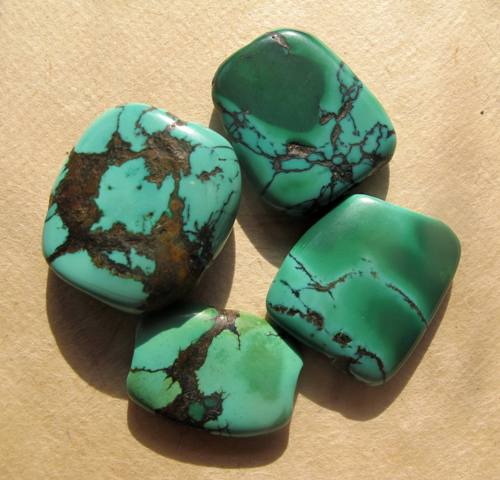
Fig. 22. These variegated blue and green turquoises are crisscrossed by a matrix of brown veins that ranges from hardly noticeable to very conspicuous. My impression gleaned from the general physical state of these stones is that they constitute a more recent type of turquoise, which was introduced on the Tibetan plateau in the last two or three centuries or so.
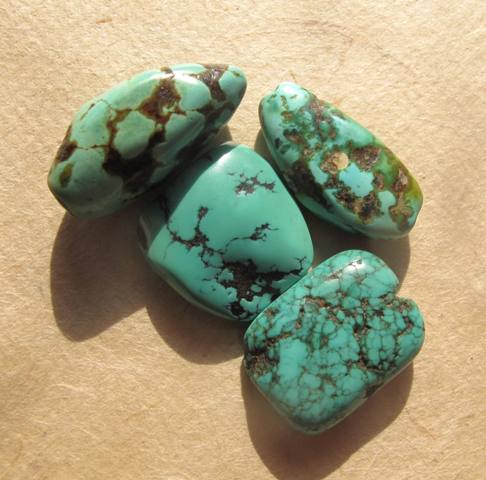
Fig. 23. These veinal matrix turquoises with their bright color is of the type commonly called drukar by Tibetans. It is still in demand by Tibetans but valued well below fine pieces of turquoise with the color of a robin’s egg. Perhaps stones with more than one provenance are represented in this photograph. I attribute these turquoises to the last 100–300 years. Some other examples may even be more recent. I think this turquoise was an import to the Tibetan plateau.
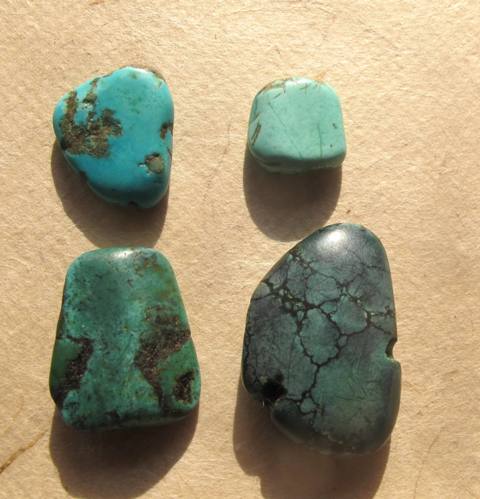
Fig. 24. Four different types of turquoises. The blue bead on the top left is from Iran or Afghanistan and must have been imported into Tibet in the last century or two. The lighter blue bead (top right) belongs with the category of turquoises in fig. 12. The blue green bead (bottom left) is of significant age, and appears to be affiliated with the lowermost bead in fig. 25. The bead (bottom right) has an unusual steel blue color. This highly worn stone is green on the other side and with a prominent matrix.
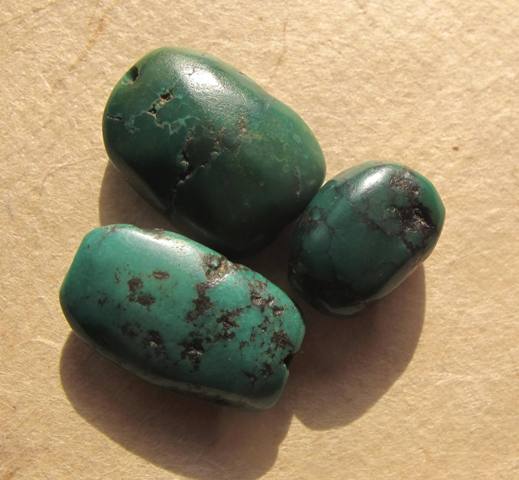
Fig. 25. Another selection of turquoises. The uppermost bead has a deep emerald color and seems to be yet another species of turquoise, which was either mined in Tibet of brought there from somewhere else.
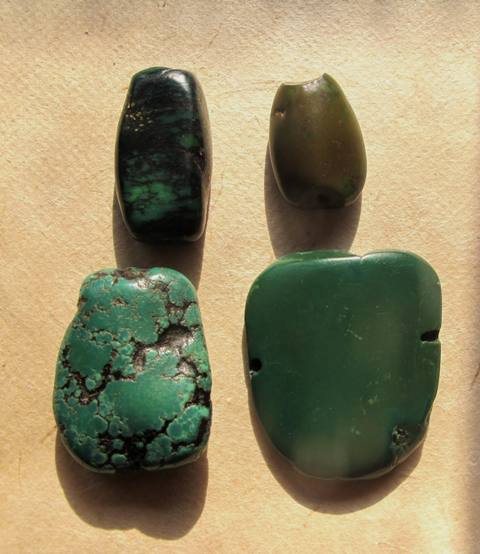
Fig. 26. Four more turquoises. The upper right bead best belongs with those depicted in fig. 13. The upper left bead with its marbled surface and yellow flecks is very unusual. This stone reveals heavy wear. The lower left bead has a lovely lime green color and is deeply marked by a dark matrix. The lower right bead appears to be yet another kind of turquoise. It has a uniform jade green color and an extremely smooth, glossy surface. This large bead with its deep patina and wear must also be of consequential age.
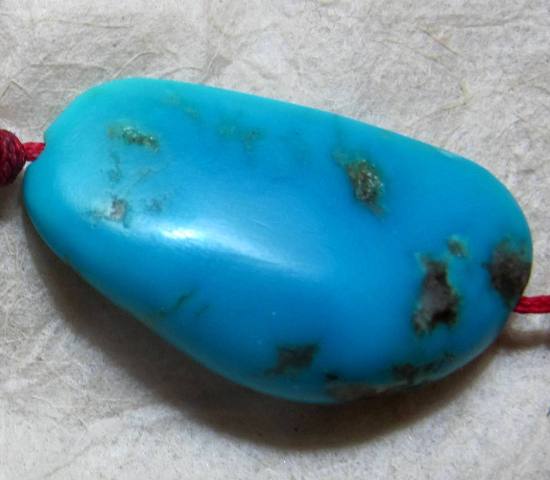
Fig. 27. A lovely sky-blue turquoise found in Tibet. This is the richest blue color of turquoise. Its patina and wear reveal that it has been used for some generations, but originally it must have come from Persia.
Antique Tibetan and Chinese Turquoise
Text and Photographs by James Wainwright
There is quite a large variety of Tibetan/Chinese/Persian turquoise specimens recovered from Tibet and the Himalayan regions. There are so many contributing factors that can determine the color and patina of a turquoise bead. How they are worn. Which side of the bead has been exposed to the skin for example. Whether they have been worn as part of a headdress or directly on the skin. I assume that some headdress beads might experience sun bleaching over time. If they have been strung with other beads it can cause deeper end wear, etc.
I am quite certain that many old turquoise beads found in Tibet are hundreds of years old if not ancient (such as some shown in the above article), but it is difficult to pinpoint age because the material has been worn and passed on through the generations. I just wish we had some rough specimens from known mines in Tibet. This would show us the natural color of the turquoise before being crafted into a bead and would help identify the regions the various types come from more easily. I do wonder how much of it was actually mined (turquoise can be found at less than 20 m) and how much was found as scree? Turquoise is often found in volcanic rock, so perhaps Northern Tibet would have been a good source in antiquity.
Unless we can find some specimens direct from a Tibetan mine, it is impossible to tell what color a bead started out as. It is clear that many turquoise beads have turned dark green from skin oils. How quickly this happens will depend on the porosity of the stone and how regularly they are worn. You often see beads that have one side (usually the flatter side) that is a darker green than the other. This indicates that the darker side has had the most skin contact, and so the lighter side would perhaps be closer to the original color of the material.
The bluest beads will always hold the greatest allure for Tibetans, and the best pieces are believed to come from Iran. I wonder when this supply dried up? I do believe that many beads sourced in Tibet and the Himalaya are of Tibetan origin (not all of it comes from China as some would like us to believe), but not knowing where these turquoise mines were located this view is difficult to confirm. Also, because there is now little turquoise in the marketplace, it is certain that mining in Tibet (for turquoise) is no longer happening or is only on a very small scale. The modern Chinese beads we see have all been treated in some way and many are not turquoise at all. I have seen some very convincing Variscite beads that, unless you knew it was Variscite, it would be impossible to tell them apart from true torquoise.
If we look at some more recent Chinese beads they are often a pale blue with quite a bit of matrix in the stone. They are also likely to be treated with wax or paraffin and this of course protects them from changing color or falling apart. Most turquoise cabochons used in jewelry have gone through this process. I doubt that any of the antique Tibetan/Chinese/Persian turquoise was treated, so it could indicate that material in antiquity was much more stable than what is being mined in recent times. I have quite a bit of uncirculated antique Chinese turquoise, and this is more on the pale bluish green side with lots of matrix and is almost chalky in texture.
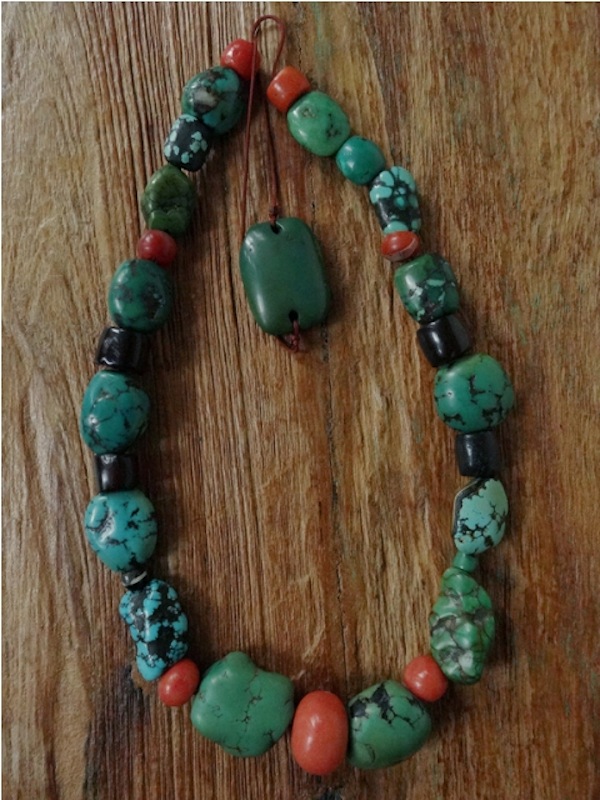
Fig. 0. This necklace has a variety of turquoise beads that have just seemed to stay with me. Some of the beads have amazing wear at the perforations and the stringing cord has also cut deeply into the stone over time. There is still room for a few more beads on this strand, which I will add as and when I find them. All were acquired in Nepal over the past 14 years.
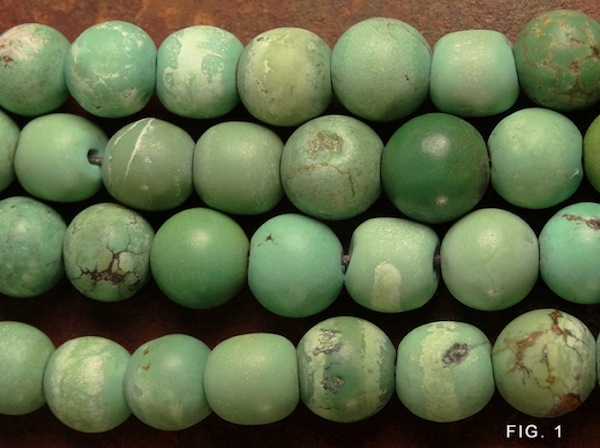
Fig.1. These beads once adorned a Chinese belt dating to the late 19th century. Some beads are slightly stained on the surface, which is leftover from the glue used to keep them secured to the fabric. They are mostly pale in color and display very little matrix. They are also quite dry, almost chalky to the touch and do not have the patina and feel of turquoise that has been in circulation within the Himalayan regions.
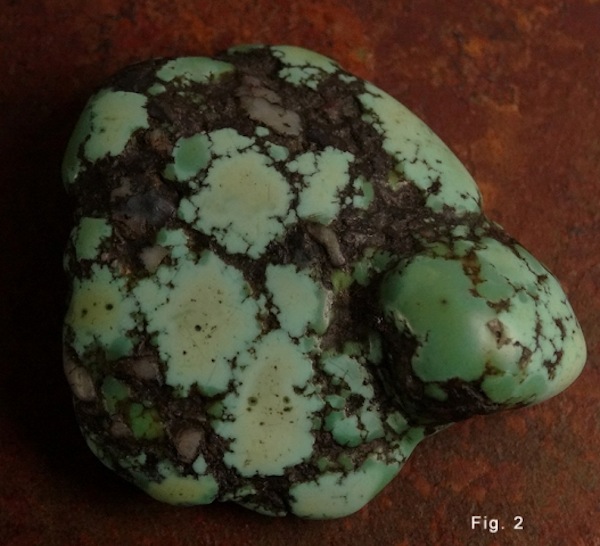
Fig. 2. Antique turquoise bead with quartz inclusions in the matrix. Many old turquoise beads found in Tibet and Nepal are often freeform in shape. Perhaps some were recovered from mountain scree, with little more needing to be done than a stringing hole, although I suspect that some form of polishing was involved. Whereas most contemporary Chinese turquoise beads have clearly been given a more uniform shape and are well polished. This bead was found in Nepal, but likely came out of Tibet. Whether it was originally traded from a mine in China or Tibet is unknown. I have no doubt that Tibetans had their own indigenous sources of turquoise and, due to popular demand, they also imported turquoise from China and Persia. The ‘robin egg blue’ turquoise that Tibetans really prize is said to have originated from Iran and was traded along the Silk Road to Tibet.
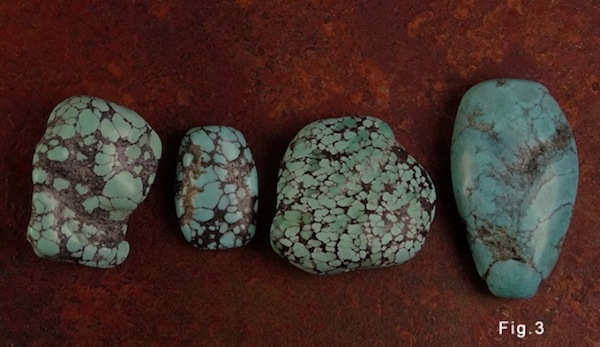
Fig. 3. A group of four antique Chinese turquoise beads that have not been circulated in Tibet or the Himalayan regions. They are believed to be 19th century creations obtained from an old collection in the United Kingdom. These beads have not been worn next to the skin and therefore have not undergone any color change. They do not appear to be treated. They are a pale color, more blue than green and have an almost chalky texture. I suspect that this would change over time if they were worn on the body. Perhaps many of the antique turquoise beads we see coming out of Tibet started life looking like this?
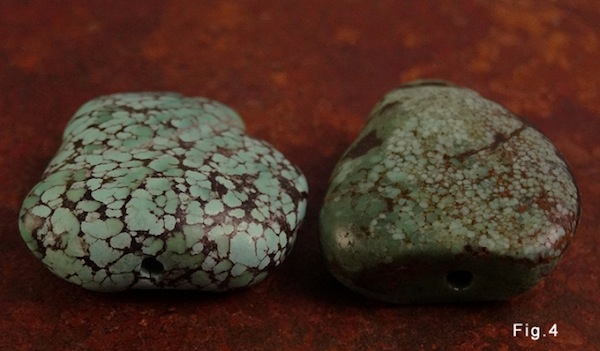
Fig. 4. The bead on the left is believed to be an untreated Chinese turquoise bead (19th century) that has not been circulated in Tibet or the Himalayan regions. It has a pale blue color and displays a dense matrix. The bead on the right was acquired from Nepal and likely came out of Tibet. It is unknown if it was mined in Tibet or was traded to Tibet from China. It is clear that the bead on the right has been worn on the body for long periods, turning the bead a darker green in places. Traces of a much lighter color can still be seen on the side shown, which indicates this side had less contact with the skin. The matrix is also dense and has areas rusty red in color. You can see that this bead was strung with other beads and due to rubbing against them has acquired flattened ends.
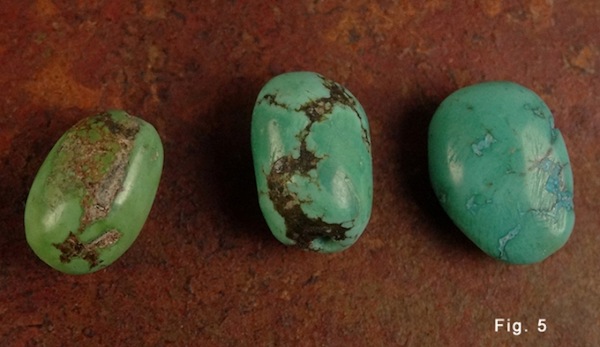
Fig. 5. Three modern turquoise beads (approx 13 mm in length) made in China and purchased in Nepal. Most modern turquoise beads sold in Tibet or Nepal tend to be a more uniform oval shape and it is likely that all are treated in some way. These beads display no signs of being strung with other beads and there are no areas of color change indicative of being worn on the body. Beads of this type can range in color from light blue to dark green and it is possible that many are dyed to give a more uniform color to the material. The perforations in new turquoise beads are typically much smaller than antique beads. Many older beads will have holes enlarged by cord that has cut into the material over time. Also, with older beads, the holes might not perfectly align in the middle. Modern turquoise beads will typically have very straight and uniform machine-drilled holes.
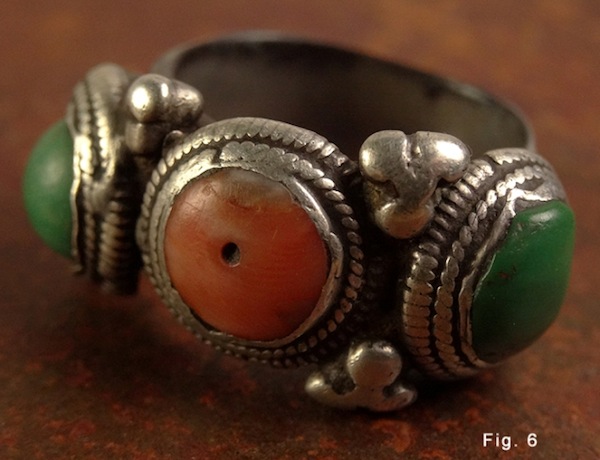
Fig. 6. Old silver ring inlaid with turquoise and coral cabochons. Collected in eastern Tibet. Many damaged beads were often given a new lease of life by using them as cabochons in jewelry.

Fig. 8. Antique turquoise bead worn smooth from being handled and worn on the body, possibly for centuries. The ends have been re-shaped by rubbing against other beads. The holes are enlarged and polished smooth from the action of rubbing against the stringing cord. This bead was found in Nepal.
For more images of antique Tibetan turquoise, see: http://www.garudashop.com/Turquoise_beads_s/31.htm
Notes and Addendum on: Tibetan Turquoise: Beaming stone of life
Text and photographs by Stephen Shucart
General Introduction
When did humans first start wearing beads and why did they start? According to Lois Sherr Dubin, in the The History of Beads (2009, p. 19):
… the earliest known beads are associated with Middle Paleolithic people. They were discovered at Skhul Cave on Mount Carmel and have been dated to approximately 108,000 B.C., at about the time Homo sapiens populations were replacing the Neanderthals and developing new and more complex cultures.
Both those beads and some found at the nearby Qafzeh Cave dating from 92,000 B.C. were either naturally pierced or pierced by predators. But a group of 32 beads from Grotte des Pigeons in eastern Morocco, dating from 82,000 B.C., were intentionally perforated.
What is the significance of this? Anatomically, homo sapiens evolved to their current state approximately 200,000 years ago, but, for the first 100,000 years they exhibited little culture difference from their forebears. Then, suddenly, between 100,000 and 60,000 years ago, something changed. They started using syntax as well as symbols for communication; they started using complex weapons like slings, bows, and the atlatl; and they started to utilize adornment, painting themselves with ocher and wearing beads. Thus beads are one of the earliest, overt signs of the emergence of a new degree of mental complexity and human culture.
And we’ve been wearing beads ever since.
Turquoise
I’ve been involved with buying and selling turquoise since the late 1960s, when I was a jeweler selling my wares on the streets of San Francisco. In 1972, I first traveled overland to Asia, stopping in Mashad, Iran to purchase black spider-web matrix turquoise mined near Nishapur, and after a year living in Afghanistan, traveled to Nepal and purchased kilos of old Tibetan turquoise beads in Kathmandu. During the 1980s, I was a gemologist and lapidary, co-owner, with Dharma Dan Rollins, of Triple Gem Lapidary in Boudhanath, Nepal. One of our specialties was to re-cut broken Tibetan turquoise beads into cabochons, thus I literally know turquoise inside out.
One of my first addenda is the fact that the Persian term for turquoise is commonly spelled ferozah in the Roman alphabet, and it means ‘Victory’ or ‘Victorious’. The mountains of Western Afghanistan where the fabled Minaret of Jam is to be found are named the Ferozkoh, or Turquoise Mountains.
As a gemologist, my preferred reference book while traveling is Gemstones of the World by Walter Schumann. He states:
Most of the so-called turquoise found in the United States contains Fe (substituting for Al) and is thus really a mixture with chalcosiderite. Iron imparts a greenish color.
The popular sky-blue color changes at 482 degrees F (250 degrees C) into a dull green. A negative change in color can also be brought about by the influence of light, perspiration, oils, cosmetics, and household detergent, as well as loss of natural water content. (1999, p. 170).
Over 90% of turquoise found on the market has been tampered with in some form or another. The most common is stabilization. Since the stone is so porous it is often soaked in an artificial resin, which improves the color and hardens the surface. The color is also enhanced by heating it with oil or paraffin. Many beads from China have distinctive brown discoloration on them, this is indicative of being too close to the heat during the treating process. Touching a hot needle to the back of stabilized or paraffin-treated turquoise will cause it to give off a ‘melting plastic’ smell.
When working as a lapidary, we discovered one more interesting fact about untreated turquoise’s natural discoloration from oil absorption due to aging. If the stone was originally blue in color and closer to 6 than 5 on the Moh’s hardness scale, it was possible to restore the earlier, more desirable color, though the patina of age was lost. When we were cutting broken beads into cabochons, we often encountered beads where the green discoloration was only a few millimeters in depth. Simply regrinding and polishing the stones restored the bright blue shade they first possessed.
Turquoise in Myth and Culture
I find it interesting that cultures as distant as Native American and Tibetan both associate turquoise with protection against travel disasters, especially when traveling by horse. I also remember a Tibetan friend once telling me that a turquoise earring would prevent reincarnation as a donkey. My curiosity piqued, I did a little online research and discovered the following:
The significance of light and shade is reflected in the supremacy of the semi-precious stone turquoise in the daily spiritual and religious life of the devout Buddhist, who holds various beliefs about this stone. In general terms turquoise is a symbol of the blue of the sea and the sky. Infinity in the sky speaks of the limitless heights of ascension. The stone is opaque as the earth, yet it lifts the spirit high, laying bare to us the wisdom of both the earth and the sky. When worn in a ring, it is believed to assure a safe journey; worn in the ear it prevents reincarnation as a donkey; appearing in a dream, it is auspicious; when found, it brings the best of luck and gives new life (in contrast, it is not considered lucky to find gold or coral); when changing its color to green, it indicates hepatitis, yet at the same time it draws out jaundice. Most importantly it is believed to absorb sin. Strings of prayer beads too include turquoise. In fact, when worshiping the popular goddess Tara in her green form, because of the color association, it is desirable to do so with a rosary entirely composed of turquoise beads. There also exists as well the concept of living and dead turquoise. Living turquoise has a healthy blue color, whereas dead turquoise has turned either white or black. In the natural aging process of turquoise, exposure to light and body oils darkens the color, eventually turning it black. Tibetans compare this to human aging and death. Wearing “living” turquoise is therefore very desirable, as it will give long life to the wearer.
See: http://www.kheper.net/topics/Buddhism/colors.html
Conclusion
To conclude this short addendum I would like to present a few photos of some turquoise beads in my personal collection. I also include pictures of turquoise bought in Afghanistan. The Afghan beads show the probability that many of the ‘Tibetan’ turquoise beads originally came from Afghanistan or Iran.
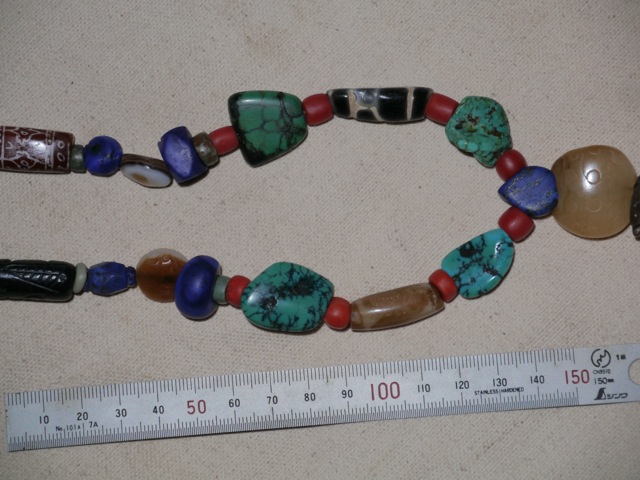
Fig. 4. Necklace, lower section with four large Tibetan turquoise beads. The other beads on the strand include Khotanese mutton-fat jade (nephrite), 400–600 B.C.; Afghan lapis, coral, two Tibetan gzi beads; discs of Mayan (Belize) blue jade (jadeite); banded agate eye-beads from Herat; a Bronze-age steatite cylinder seal from Balkh, and an etched carnelian from Bamiyan.
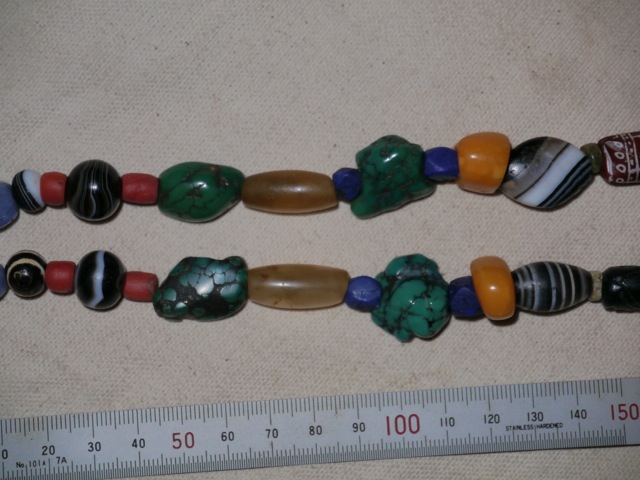
Fig. 5. The same necklace as in Fig. 4, upper part. Black banded agates; Tibetan amber (Baltic); faceted lapis; Tibetan Turquoise; Khotanese mutton-fat jade beads; Tibetan turquoise; coral; black-banded agates, three with natural patterns and one with an etched eye.
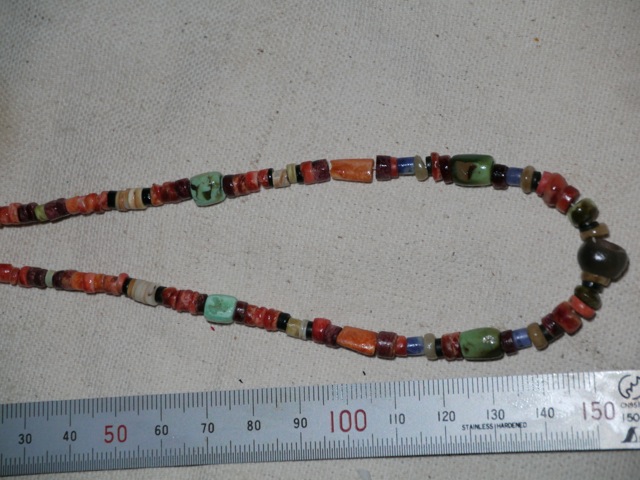
Fig. 8. Pre-Incan beads, Chan-Chan, Peru – Chimu Culture, 1000-1470 AD. Orange, purple, and white spondylus shells, blue opal, malachite, and turquoise. The Peruvian beads are presented as a mere curiosity, for comparative purposes only.
Excerpt from an article pertaining to turquoise by Samten G. Karmay
It is with much pleasure that a contribution to the study of Tibetan turquoise, made by the eminent Tibetologist Professor Samten G. Karmay, can be included in this issue of Flight of the Khyung. To anyone interested in the cultural and religious history of Tibet, his is a well-known name. For those of you less versed in the study of Tibet, Samten G. Karmay is one of the foremost Tibetologists of our time, whose pioneering studies on the Bon religion remain extremely influential.
In 1980, Dr. Karmay joined the National Center of Scientific Research, Paris, advancing to become the Director of Research in history and anthropology. In 1996, he was elected President of the International Association of Tibetan Studies. He has written a number of books on Tibetan religion and culture, including Little Luminous Boy. The Oral Tradition from the Land of Zhang Zhung (1988), The Treasury of Sayings: A Tibetan History of Bon (1972), Secret Visions of the Fifth Dalai Lama: The Gold Manuscript in the Fournier Collection Musée Guimet (1991), etc.
Thanks to the generosity of Samten G. Karmay, some of his writings on turquoise are quoted below. For the print version of this work and many other facets of Tibetan ritual study, please see:
1998. “The Soul and the Turquoise: A Ritual for Recalling the bla (trans. V. Martin)” in The Arrow and the Spindle: Studies in History, Myths, Rituals and Beliefs in Tibet, pp. 310–338 (this paper originally appeared in l’Ethnographie, Tome LXXXIII, pp. 97–130. Paris, 1987). Kathmandu: Mandala Book Point.
“Turquoise: Symbol of the Soul” (pp. 318–320)
If there is one stone that has always played an important role in Tibetan culture from the royal period to the present, it is definitely turquoise. Not only is it regarded as a precious stone and beautiful ornament, but it is also believed to possess certain mythical properties. Its function as an ornament is twofold: on the one hand, it is the symbol of the soul (bla g.yu): and on the other, it is a token of love.
In the bla bslu [recalling the soul] ritual, it is the chief officiant who ties the bla g.yu around the devotee’s neck. The latter must care for it as much as possible, for its loss or damage could affect his own soul. Turquoise is known to change color during the day according to the surrounding light (1). Its paleness is often seen as a bad omen. I will discuss this later, in relation to the role of turquoise in the myths as well as in the rituals themselves.
In marriage rites, the woman offers a turquoise to the man as a token of love whereas the man offers her a gold coin (bla gser). (2) In other texts, it is the man who gives the turquoise called gtsug g.yu or thod g.yu, the ‘head turquoise’ which is attached to the woman’s head, while another person sings its praise (g.yu bshad). (3) The gtsug g.yu is the ornament most closely associated with women and constitutes a gauge of her faithfulness to her partner. The following poem illustrates this point:
“My thoughts are with you, friend of my life.
If you have no modesty and feel no shame,
Your head turquoise
Cannot speak”. (4)
In the Gesar epic, during the campaign against the Hor, Gur-dkar, king of the Hor, sends four birds to different countries in quest of a wife. The blackbird who is the soul-bird (bla bya) of the Hor flies over Tibet and eventually reaches Gling, Gesar’s birthplace. There, he notices ’Brug-mo, Gesar’s wife, in the company of two girls combing her hair. The blackbird is deeply impressed by ’Brug-mo’s beauty and succeeds in stealing the turquoise she has removed from her forehead (thod g.yu) and put aside in order to set her hair. The blackbird then returns to Hor and gives the king the turquoise. He tells him of ’Brug-mo’s beauty. Later ’Brug-mo is then kidnapped and, for a time, becomes the wife of Gur-dkar, king of the Hor and Gesar’s enemy. (5)
Even today turquoise is still a source of literary inspiration: a long novel by dPal-’byor simply entitled gTsug g.yu has recently been published in Lhasa. (6)
The combination of gold and turquoise is very common not only in ornaments, but also in popular rituals as offerings. This combination is mentioned in many early documents, (7) and it is worth describing how gold and turquoise are used together in certain Bonpo rituals. According to the instructions given in one of the ritual texts, “the ritual is to be chanted while chewing the gold and the turquoise”. (8) In practice, the officiant keeps a gold coin inside his right cheek and a turquoise inside his left cheek; these two objects are respectively referred to as the ‘moth gold’ (kha gser) and the ‘mouth turquoise’ (kha g.yu). The meaning behind this practice, however, is not made clear. According to Tenzin Namdak, it marks the ‘importance’ of the rite performed by the officiant. This is more or less confirmed by the following statement from gZer mig by gSer mig, Drang-rje btsun-pa: “the gold and turquoise of the mouth are symbols of Wondrous Speech”. (9) However, kha gser and kha g.yu also refer to beer (chang) and tea offerings. The tea, poured into a receptacle containing a gold coin, is known as the ‘gold beverage’ (gser skyems) while the chang, poured into a receptacle containing a turquoise, is called the ‘turquoise beverage’ (g.yu sngon).
Notes
1. The turquoise is considered as a medicinal substance. In certain medical texts, one speaks of eight kinds of turquoises. Two out of the eight are particularly known for their bright color: “the drug dkar is blue and white and shines brilliantly. It can be seen in the dark” (sngo zhing dkar la bkrag mdangs che la mun par mthong ba de drug dkar); “the drug dmar is soft and blue with great reddish brilliancy” (sngo zhing dmar mdangs che la snum pa drug dmar), see Dri med shel phreng by bsTan-’dzin phun-tshogs, p. 85. For a geological study, see
Walker-Watson, 1983, “Turquoise: The Gemstone of Tibet” in The Tibetan Review, June, pp. 16–18.
Cf. also Berthold Laufer, 1913-14, “Notes on turquoise in the East” in Anthropological Series (Chicago), Vol. XIII, pp. 5–20.
Corneille Jest, 1985, “La turquoise de vie, une pèlerinage tibétain”, Paris: Editions A.M. Métalié.
2. See the marriage ritual in Karmay 1998: “A General Introduction to the History and Doctrines of Bon” in The Arrow and the Spindle: Studies in History, Myths, Rituals and Beliefs in Tibet, pp. 147–153.
3. rDo-ring bsTan-’dzin dpal-’byor, dGa ’bzhi ba’i mi rabs kyi byung ba brjod pa zol med gtam gyi rol mo, Si khron mi rigs dpe skrun khang, 1987, Vol. I, pp. 253-54; P. W. Barshi, gNa’ rabs bod kyi chang sa’i lam srol, Dharamsala, 1979, pp. 7, 8, 32.
4. gtan grogs khyod la bsam pa’i / khrel dang ngo tsha med na / mgo la rgyab pa’i gtsug g.yus/ skad cha bshad ni mi shes/ Rig ’dzin tshangs dbyangs rgya mtsho’i gsung mgur dang gsang ba’i rnam thar, Mi rigs dpe skrun khang, 1981, p. 10, No. 26.
5. Ngag-dbang bstan-’dzin phun-tshogs, ’Dzam gling ge sar rgyal po’i sgrung/ Hor gling g.yul ’gyed, Lhasa, Bod ljongs mi dmangs dpe skrun khang , 1980, pp. 2–7.
6. Bod ljongs mi dmangs dpe skrun khang , 1985.
7. E.g. IOL No. 730 (De la Vallée Poussin, 1962).
8. de nas dbu la thod bcing/ kha gser kha g.yu zhal du mur/ gser dang g.yu yi sgron me bteg/ mda’ dar phyar la ’di skad do/, “Then put on the turban on the head; chew in the mouth the kha gser and kha g.yu; offer the gold and turquoise lamps; flourish the ritual arrow” (mKha’ klong gsang mdos, p. 280; Karmay, 1977, No. 30, 10).
9. kha gser kha g.yu ngo mtshar bka’ yi rtags (Vol. II, chapter XIV, f.287).
